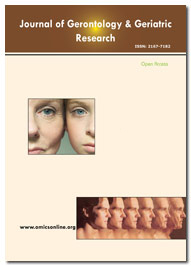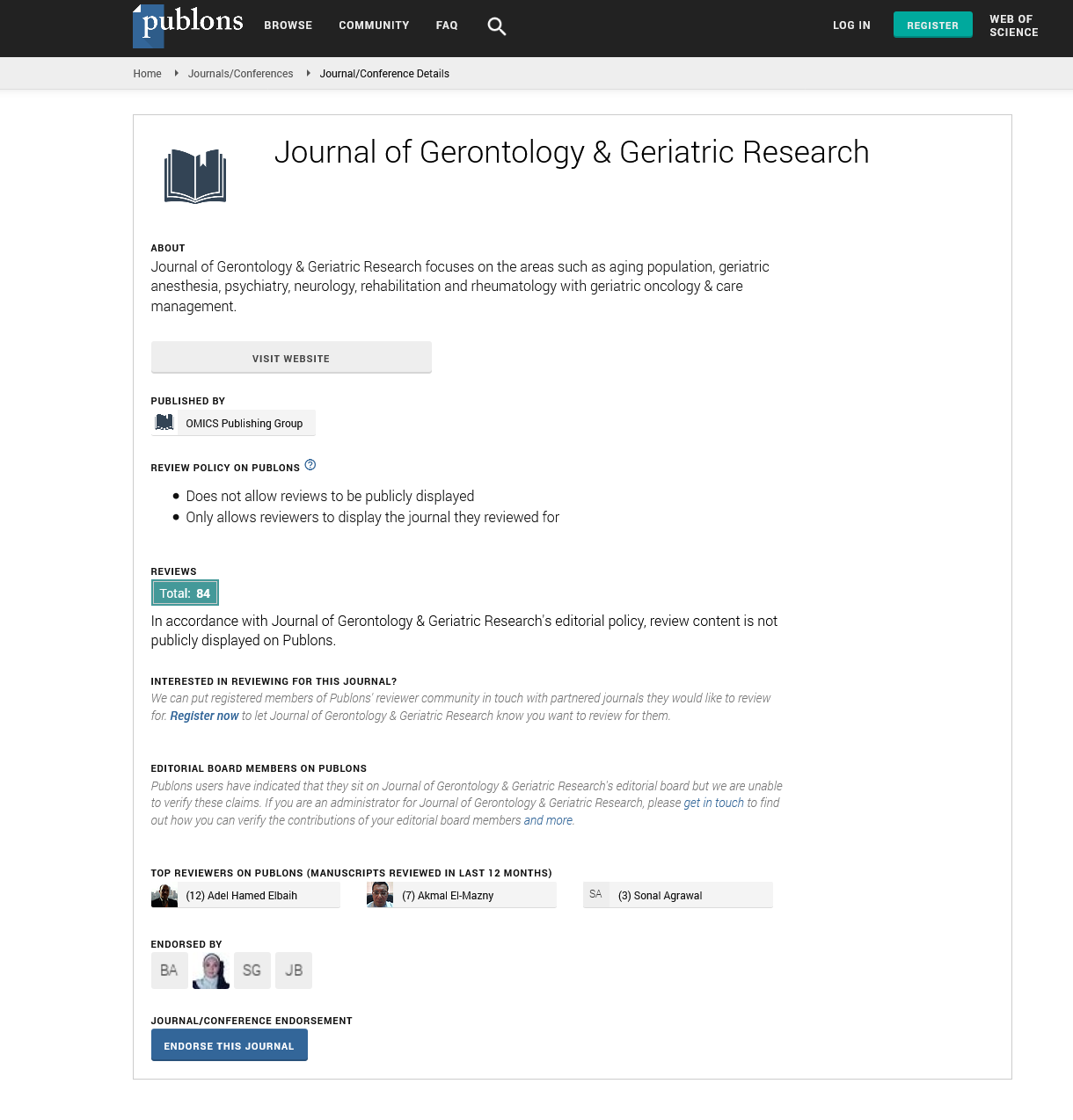Indexed In
- Open J Gate
- Genamics JournalSeek
- SafetyLit
- RefSeek
- Hamdard University
- EBSCO A-Z
- OCLC- WorldCat
- Publons
- Geneva Foundation for Medical Education and Research
- Euro Pub
- Google Scholar
Useful Links
Share This Page
Journal Flyer

Open Access Journals
- Agri and Aquaculture
- Biochemistry
- Bioinformatics & Systems Biology
- Business & Management
- Chemistry
- Clinical Sciences
- Engineering
- Food & Nutrition
- General Science
- Genetics & Molecular Biology
- Immunology & Microbiology
- Medical Sciences
- Neuroscience & Psychology
- Nursing & Health Care
- Pharmaceutical Sciences
Opinion - (2024) Volume 13, Issue 2
Technological Interventions for Enhancing Mobility and Independence in Geriatric Populations: A Systematic Review
Armando Valdivieso*Received: 01-Apr-2024, Manuscript No. jggr-24-25826; Editor assigned: 02-Apr-2024, Pre QC No. P-25826; Reviewed: 16-Apr-2024, QC No. Q-25826; Revised: 22-Apr-2024, Manuscript No. R-25826; Published: 30-Apr-2024, DOI: 10.35248/2167-7182.2024.13.723
Introduction
This longitudinal study explores how social interactions and community engagement influence longevity and quality of life in older adults. The research uses data from a 10-year follow-up study of individuals aged 70 and above, highlighting the positive effects of social networks and participation in community activities. As global populations age, maintaining mobility and independence becomes crucial for the quality of life in geriatric populations. Mobility is a key factor in enabling older adults to engage in daily activities, socialize, and live independently. Technological interventions offer promising solutions to address the mobility challenges faced by older adults. This article systematically reviews recent advancements in technology aimed at enhancing mobility and independence among the elderly.
The aging of global populations presents a unique set of challenges, particularly concerning mobility and independence among older adults. Mobility, encompassing the ability to move freely and safely, is crucial for maintaining independence and participating in various activities [1-3]. However, with age, individuals often experience declines in physical strength, balance, and coordination, which can significantly impact their mobility. Technological interventions offer promising solutions to address these challenges by providing support, enhancing safety, and promoting independence among older adults. From assistive devices to smart home technologies and rehabilitation tools, a wide array of innovations has emerged to cater to the diverse needs of geriatric populations.
This systematic review analyzes peer-reviewed articles, clinical trials, and meta-analyses published between 2015 and 2023. Databases such as PubMed, IEEE Xplore, and Google Scholar were searched using keywords including "geriatric mobility," "assistive technology," "elderly independence," and "smart home technology." Inclusion criteria focused on studies involving technological interventions specifically designed to enhance mobility and independence in adults aged 65 and above.
Description
Traditional mobility aids like canes, walkers, and wheelchairs have seen significant technological upgrades. Modern walkers are now equipped with sensors and brakes to prevent falls, while smart wheelchairs offer navigation assistance and voice control features. These devices are designed to be user-friendly and adaptable to individual needs, thus improving mobility and safety.
Wearable exoskeletons have emerged as a revolutionary aid for those with severe mobility impairments. These powered suits assist with walking by providing additional support and strength to the user's legs, enabling them to move with greater ease and stability. Studies have shown that exoskeletons can significantly improve walking speed and endurance in elderly users. Smart home technologies, including automated lighting, temperature control, and voice-activated assistants, help create a safer and more accessible living environment. These systems can be customized to individual needs, reducing the physical effort required to perform daily tasks and thus promoting independence.
Fall detection systems, integrated with smart home networks, use sensors and cameras to monitor movement and identify falls in real-time. These systems can alert caregivers or emergency services immediately, providing timely assistance and potentially reducing the severity of fall-related injuries. Robotic devices designed for physical therapy offer tailored exercises that can be performed at home under remote supervision. These devices use machine learning algorithms to adapt to the user’s progress, ensuring optimal rehabilitation outcomes. Such technologies have been particularly effective in improving balance and gait in older adults.
VR-based rehabilitation programs immerse users in a virtual environment where they can perform mobility exercises in a safe and engaging manner. These programs often include gamified elements to increase motivation and adherence to exercise regimens. Research indicates that VR can enhance balance, coordination, and overall physical activity levels in the elderly. Wearable devices like fitness trackers and smartwatches monitor vital signs, physical activity, and sleep patterns. These devices provide valuable data that can be used to tailor fitness programs and monitor health conditions [4,5]. Some advanced models also offer fall detection and emergency alert features, contributing to safer mobility and independent living.
For elderly individuals with cognitive impairments such as dementia, GPS tracking devices offer a safety net by allowing caregivers to monitor their location. These systems help prevent wandering and ensure that help can be dispatched quickly if needed. The integration of these technologies into the daily lives of older adults can significantly enhance their mobility and independence. However, several challenges remain, including the high cost of advanced technologies, the need for user-friendly designs, and ensuring privacy and security of users' data. Further research is necessary to address these issues and to evaluate the long-term impact of these interventions on the quality of life of elderly individuals.
Conclusion
Technological interventions hold great promise for enhancing mobility and independence in geriatric populations. From advanced mobility aids and smart home systems to robotic rehabilitation devices and wearable health monitors, these innovations are transforming the way older adults live. Continued advancements and accessibility improvements in these technologies are essential for supporting the growing elderly population in maintaining their independence and quality of life.
References
- Hutchins LF, Unger JM, Crowley JJ, Coltman Jr CA, Albain KS. Underrepresentation of patients 65 years of age or older in cancer-treatment trials. N Engl Med 1999;341:2061-2067.
- Talarico L, Chen G, Pazdur R. Enrollment of elderly patients in clinical trials for cancer drug registration: A 7-year experience by the US Food and Drug Administration. J Clin Oncol 2004;22:4626-4631.
- Haraldstad K, Wahl A, Andenæs R, Andersen JR, Andersen MH, Beisland E, et al. A systematic review of quality of life research in medicine and health sciences. Qual Life Res 2019; 28:2641-250.
- Ismail Z, Gatchel J, Bateman DR, Barcelos-Ferreira R, Cantillon M, Jaeger J, et al. Affective and emotional dysregulation as pre-dementia risk markers: Exploring the mild behavioral impairment symptoms of depression, anxiety, irritability, and euphoria. Int Psychogeriatr 2018; 30:185-196.
- Ohrnberger J, Fichera E, Sutton M. The relationship between physical and mental health: A mediation analysis. Intern Med J 2017; 195:42-49.
Citation: Valdivieso A (2024). Technological Interventions for Enhancing Mobility and Independence in Geriatric Populations: A Systematic Review. J Gerontol Geriatr Res. 13: 723.
Copyright: © 2024 Valdivieso A. This is an open-access article distributed under the terms of the Creative Commons Attribution License, which permits unrestricted use, distribution, and reproduction in any medium, provided the original author and source are credited.

